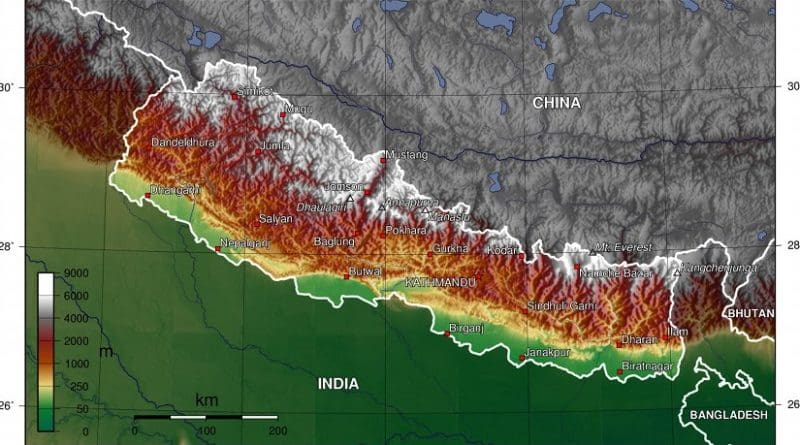China: Engaging Nepal As A Land Port – Analysis
By IPCS
By Teshu Singh
Given its strategic location, Nepal is of immense importance to both India and China. On the north it is surrounded by China (TAR) and on south, east and west by India. Economically, Nepal can act as a bridge between India and China. The commentary addresses three specific questions – How does Nepal fit into China’s South Asia policy? What are strategic implications of the economic and infrastructure investment by China? Are these investments only to counter Indian influence in Nepal or is there is a larger game plan?
From ‘Buffer’ to ‘Bridge’
The year 2012 was observed as Sino-Nepal friendship year. Nepal and China share a 1414 km long border; Mao Zedong called Nepal as one of the fingers in China’s five fingers policy. The policy was meant to serve as a new buffer zone between India and China after the ‘old buffer’ (Tibet) came under China’s sovereign control in 1951. http://www.ipcs.org/issue-brief/china/india-china-and-the-nathu-la-understanding-beijings-larger-strategy-204.html.
As a part of its western development strategy, China is planning to build a 256 km extension of the 1956 Golmud-Lhasa railroad to the Nepal border by 2014. The first extension of this line is planned westward to Shigaste. The Shigatse prefecture borders India, Bhutan, and Nepal and is 270 km towards Nepal from Lhasa. Further extending the Chinese National Rail Network, to link Lhasa with Nyinchi in the east, this rail extension will reach the out skirts of Kathmandu. This will bring China close to Nepal and help cross the Himalayas and establish it influence up to the foothills bordering India. This endeavor will join Nepal and the TAR of China. In January 2013, Chinese ambassador Yang Houlan in The Republica, stated, Kathmandu could be a trade gateway to New Delhi: “From an economic viewpoint, Nepal links China (with 1.3 billion people) with South Asia (with 1.5 billion). The huge common market provides great opportunities for both China and South Asia.”
Notably, there are five points for overland trade on the China-Nepal border, out of which Kodari is the only legal point of entry between China and Nepal. Other routes cut through the Himalayas. Kodari road provides a direct strategic connection between China and Nepal through the difficult terrain route of Tibet. Traders can travel to the Kodari road and get across the narrow Friendship Highway and enter Zhangmu in Tibet. The Friendship Highway (China-Nepal Highway) connects Lhasa with the Chinese – Nepalese border at the Sino-Nepal Friendship Bridge between Zhangmu and Kodari. It includes the westernmost part of China National Highway 318 that runs from Shanghai to Zhangmu.
Lack of infrastructure has been a major hurdle for trade with Nepal. Taking this into contemplation, China is constructing Inland Container Depot (ICD); a dry port; Tatopani near the “friendship bridge”. The aim of the port is to simplify and facilitate trade with China through Tatopani customs. The construction of the dry port will add new dimension to the existing Nepal-China trade through increased import/ export activities. Simultaneously, the up gradation of Araniko Highway will go on along with the dry port. This highway further connects Kathmandu to Kodari. At the Friendship Bridge, it connects with China National Highway 318 to Lhasa and eventually to Shanghai.
On the other side of the border, in 2009, China has already opened a port of entry at Gyirong in TAR. It will be a major passage for land trade with Nepal. Making it a “cross border free trade zone”, it is looking forward to expand its engagement vis-à-vis Nepal.
China’s Larger Game Plan in Nepal
The aforementioned rail and road links are an endeavour to increase the connectivity vis-à-vis Nepal. These investments have helped China to develop Nepal as a bridge in South Asia, especially a bridge into the huge Indian market. All the trading items coming through these routes are not solely meant for Nepal; some of them enter the Indian markets, especially in the bordering states of Uttar Pradesh and Bihar. Approximately three-fourth of the goods continue to exit through the Birgunj border and onto the Kolkata port.
Amid improving infrastructure, one cannot overlook the strategic and political dimensions of these developments. Needless to mention, China’s engagement with Nepal is strongly shaped by the ‘One China Policy’. China sees Nepal as crucial to Tibet’s stability, since the country not only serves as an important transit route for Tibetans travelling to India, but is also home to a large exile population. It is conscious that Nepal does not become a breeding ground for activists campaigning for an independent Tibet. Thus, the crucial location of Tibet is also one of the reasons for Chinese inroads into Nepal.
Increasing contours of Chinese footprints in Nepal is a matter of concern for India. However, it would be oversimplification of the fact to state; China’s policy towards Nepal is just to check mate India. Rather, it is guided by its own economic need and its larger strategy of accessing ports in South and Southeast Asia.
Teshu Singh
Research Officer
E-mail: [email protected]

